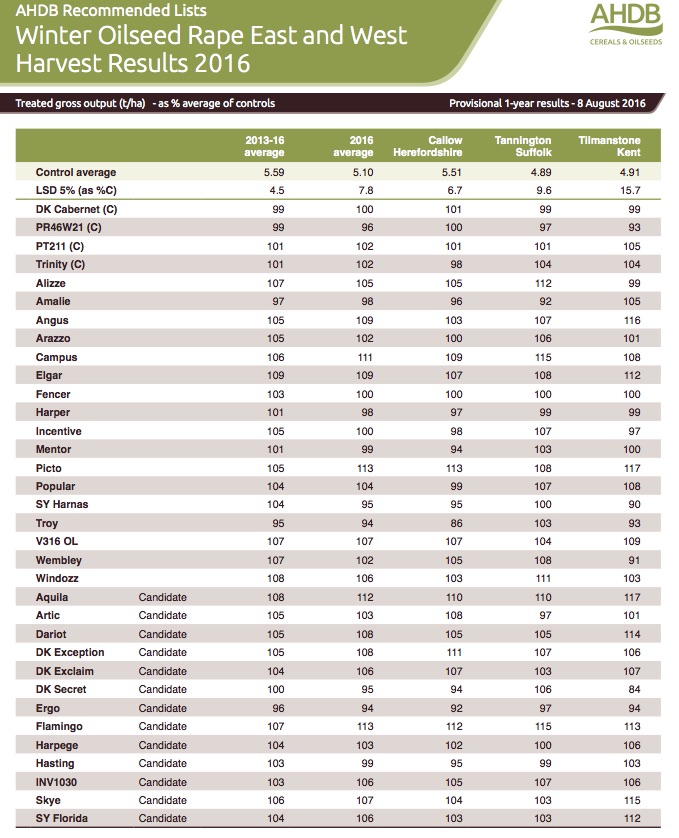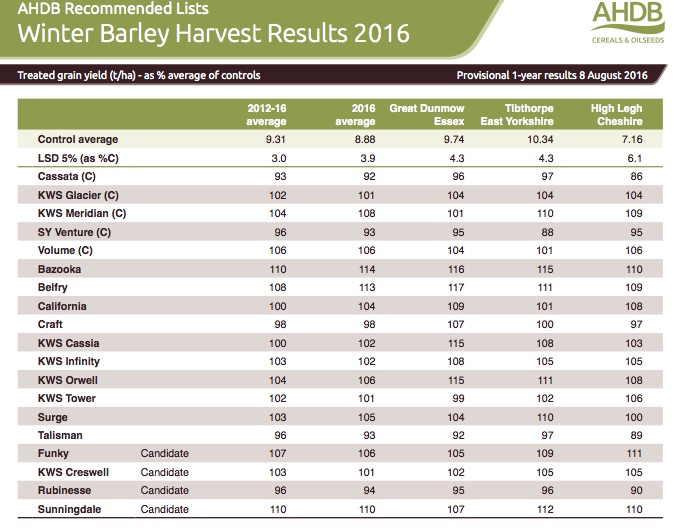Harvest Results – 9th August 2016
9th August 2016
The first oilseed rape harvest results show that this year’s yields are nearly 0.5t/ha down on the four-year average.
First three OSR trials show yields 0.49t/ha down on the four-year average
The first three winter oilseed rape (WOSR) Harvest Results for 2016 from AHDB’s Recommended Lists variety trials have been published.
The 2016 gross output value from the first three trials (from sites in Kent, Suffolk and Herefordshire) is 5.1t/ha. This is 0.49t/ha below the four-year average of 5.59 t/ha.
The three sites do however show variation in average gross output yields, with Hereford achieving 5.51t/ha but Suffolk averaging 4.89t/ha.
For individual WOSR varieties, yields are reported as a gross output, which is the seed yield adjusted for oil content. The values are represented as a percentage of the control varieties – PR46W21, DK Cabernet, PT211 and Trinity.
Currently, higher-yielding varieties include Picto (113%), Campus (111%), Elgar (109%), Angus (109%), the HOLL variety V316OL (107%) and Windozz (106%). Three of these six varieties are conventional varieties and three restored hybrids.
Four-year averages
The 2016 gross output values provide a good snapshot of variety performance this year but oilseed rape trials are often more variable than cereals and care must be taken when drawing conclusions on limited data. The four-year average values provide a better picture to variety performance over seasons.
Based on the four-year average values, the highest yielding varieties to date are Elgar (109%), Windozz (108%), Alizze, Wembley and V316 OL (all 107%), and Campus (106%).
Looking at varieties with specific agronomic features, the four-year averages show the clubroot resistant variety Mentor has a gross output of 101% and the turnip yellows virus (TuYV) resistant variety Amalie has a gross output of 97%.
Candidate performance
Gross output values for the candidate varieties in 2016 – based on the limited information – show good yields from the conventional variety Flamingo (113%) and the restored hybrid variety Aquila (112%). The relative yields are likely to change as more results are published.
First ten winter barley trials show yields 0.43t/ha below the five-year average
The latest results include three more winter barley trials from Essex, Yorkshire and Cheshire, making a total of ten sites reported to date.
The overall yield average of 8.88t/ha for 2016 continues to show a pattern of lower yields compared to the five-year average of 9.31t/ha.
Each variety’s yield is stated as a percentage of the average yield of the control varieties, which is represented as 100%. In 2016, Cassata, Volume, KWS Meridian, SY Venture and KWS Glacier were the control varieties. The 2016 control values only show yields based on one season from three sites. The five-year average is a better measure of variety performance over the past five seasons (2012–2016).
Six-row feed varieties continue to produce good yields
In 2016, the six-row feed varieties have achieved the highest yields. The hybrid Bazooka tops the yield table (114%) followed by the hybrid Belfry (113%). Volume is also performing well at 106%. KWS Meridian remains in trial as a six-row conventional variety control and has performed well at 108%. Candidate six-row varieties are also achieving good yields, with the hybrid Sunningdale yielding well (110%) and Funky (six-row conventional) at 106%.
Two-row malting varieties are judged more on their quality than outright yield. Based on current information, Craft has a yield of 98%, SY Venture 93% and Talisman 93% in 2016. The two-row feed variety KWS Orwell is currently top of the two-rows at 106%, with Surge at 105%.


